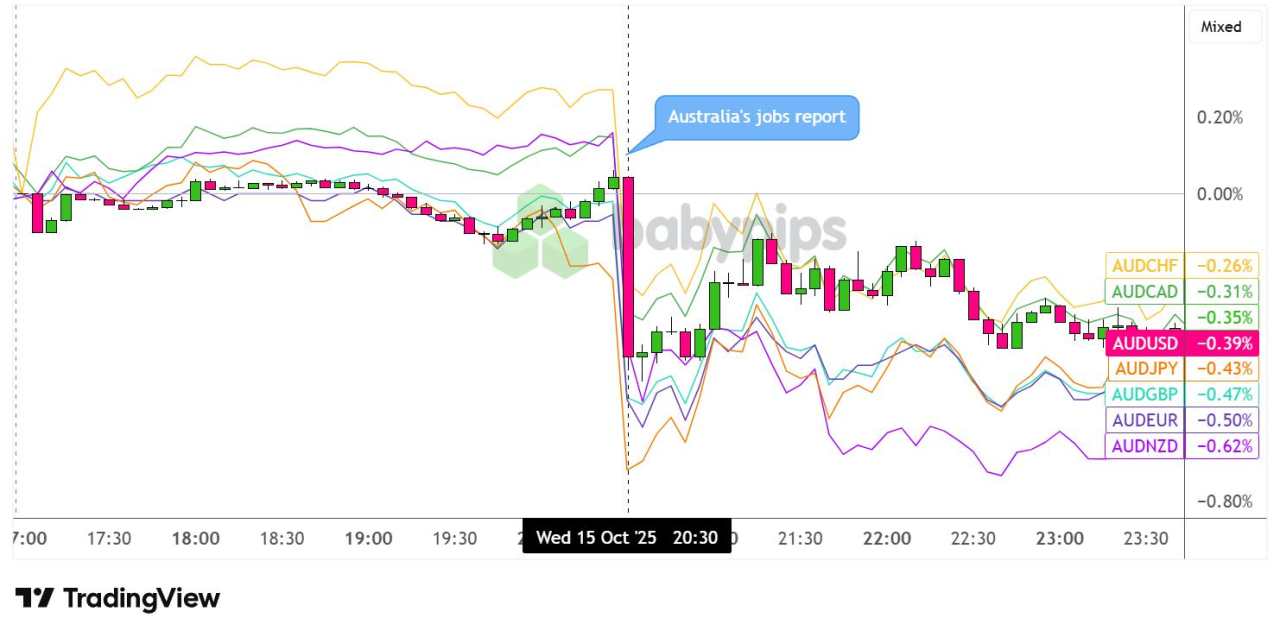Australia’s labor market weakened more than expected in September, with 34,000 workers losing their jobs and the unemployment rate jumping to its highest level in four years at 4.5%.
Analysts had expected a 20.5K increase in hiring for the month, following a downgraded 11.9K loss in employment back in August. The jobless rate was expected to come in at 4.3%.
Key Takeaways
- Employment fell by 34,000 in September, while only 15,000 new positions were created, resulting in a net loss well below market expectations
- Unemployment rate climbed to 4.5% (seasonally adjusted), up from 4.3% in August and marking the highest level since October 2021
- Australian dollar plunged 0.5% against the US dollar to 64.85 cents immediately following the release
- Three-year bond yields dropped 12 basis points to 3.36%, reflecting increased market expectations for RBA rate cuts
- Participation rate edged up to 67.0%, suggesting more Australians are entering the job market but struggling to find work
- Full-time employment increased by 8,700 positions, while part-time work added 6,300 jobs
- Market pricing now indicates heightened odds of an RBA interest rate cut at the November 5 Melbourne Cup Day meeting
Underlying data revealed that approximately 451,000 people entered employment during the month, while 398,000 left employment—resulting in the net decline of 34,000 positions.
This represents a notable shift from August’s dynamics, when 461,000 people entered employment and 483,000 left. The flows data suggests that while hiring remains relatively robust, job separations are beginning to stabilize, yet not enough to prevent the overall deterioration in employment levels.
Link to ABS Labour Force Survey (September 2025)
Meanwhile, the 0.2 percentage point jump in the seasonally adjusted unemployment rate from 4.3% to 4.5% exceeded most market expectations and marks the highest level since October 2021. In trend terms, unemployment held steady at 4.3%, though this masks the underlying weakness evident in the seasonally adjusted figures that economists typically focus on for month-to-month changes.
The participation rate’s increase to 67.0% adds another layer of complexity to the employment picture. More Australians are actively seeking work, but the economy appears unable to absorb them at the current pace.
Hours worked provided a slight bright spot, increasing by 9 million hours to 1,987 million in seasonally adjusted terms. However, this modest gain does little to offset concerns about the overall health of the jobs market.
Market Reaction
Australian Dollar vs. Major Currencies: 5-min

Overlay of AUD vs. Major Currencies Chart by TradingView
AUD fell sharply against the U.S. dollar (-0.39%), Canadian dollar (-0.31%), Swiss franc (-0.26%), British pound (-0.47%), euro (-0.50%), Japanese yen (-0.43%), and New Zealand dollar (-0.62%) and sustained its losses hours after the release.


加载失败()